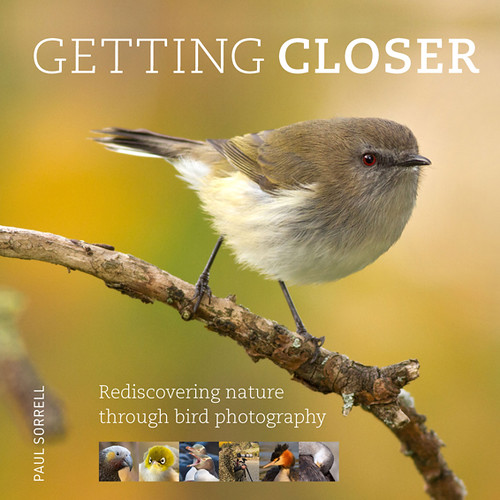Photographer Spotlight: Paul Sorrell
Always entranced by birds, I can never get enough of birdwatching–whether outside in real life, or (especially in winter) via books and the internet. We were lucky enough to publish an excerpt from renowned wildlife photographer Paul Sorrell’s new book, Getting Closer.
Paul took up photography in the early 2000s, giving him a new form of creative engagement with his longstanding interest in wildlife and the natural world. His images have featured in local, national, and international wildlife photography competitions, and he has published online and print pieces for outlets ranging from airline magazines to Tourism New Zealand's website and the School Journal. He has worked in the area of books and publishing since the 1980s, copy-editing, writing for academic and popular journals, and publishing four books about his home province of Otago with Penguin Random House.

Getting Closer teaches ways to best photograph birds and other wildlife. It inspired me SO MUCH to gaze at, learn about, and photograph birds that I asked Paul if he would share more of his extraordinary bird photography with us, this time in a photographer spotlight. LUCKY US! Without further ado, the words and images of Paul Sorrell...

A very confiding male tomtit photographed at Orokonui Ecosanctuary
How did you get interested in wildlife photography?
I’ve always been interested in the natural world and as a youngster admired the photographs in Animals Magazine (the forerunner of BBC Wildlife), which I read avidly. It seemed miraculous that people could take pictures that were so intimate in capturing the lives of animals and birds in the wild. The one photo that really inspired me, and set me on my present path, showed an osprey emerging from a lake with a salmon in its talons, enveloped in a cloud of spray. It seemed an impossible image to capture!

A white heron or kotuku fluffs out its feathers. Hawksbury Lagoon

Yellow-eyed penguins make landfall at a beach on Otago Peninsula. Sadly, these charismatic seabirds are declining in numbers
How long have you been a photographer?
I’ve been taking photos of local wildlife, mainly birds, for about 15 years. I’m still not sure if I am a photographer who is passionate about nature or a naturalist with a strong interest in photography. In the end it doesn’t matter – the two interests feed each other.

A tui pauses from feeding on native rata flowers

This great crested grebe couple would look perfect on a Valentine’s Day card!
What is your favorite place or thing to photograph?
One of the points I push in my book is that, if you want to take effective animal photos, you need a “local patch” – a place that you return to again and again, in all weathers and seasons and at different times of day. For me this place is my local nature reserve, Orokonui Ecosanctuary, about 20 minutes’ drive away from my home in Dunedin city. One species I love to photograph there are the South Island tomtits – their ready acceptance of people and tiny round, fluffy bodies make them ideal subjects.

A South Island tomtit collects moss to line her nest

Silvereye fly-by
How can photographers be a part of change in the world?
This is a great question, and I deal with it at length in Getting Closer. By viewing nature through the lens, and spending time in wild habitats (or just in our back gardens), we gain an intimate knowledge of the animals and birds around us and how they conduct their lives. It is only when we value and even love something that we will be motivated to protect it.

Welcome swallows rest on a footbridge in gentle evening light

A fernbird calls from the top of a coprosma bush
Do you have any trips planned for the future, and if so what are you looking forward to?
Because of my emphasis on the local – some of my best work has been shot out my bedroom window – I’m not too concerned about venturing far afield. Local trips to Orokonui Ecosanctuary and Hawksbury Lagoon, a nearby wetland, are always on the cards. Of course, it’s good to get away somewhere different, and my “photo buddy” Neale and I are looking forward to making it back to Fiordland National Park (at the bottom of New Zealand’s South Island) and the opportunity to photograph rare birds like rock wrens and blue ducks.

A rock wren in its alpine home. Gertrude Valley, Fiordland National Park

This royal spoonbill is having a bad hair day at my local wetland
Any photography tips you want to share?
I keep having to learn that if you want really sharp shots (and who doesn’t?), you need to dial in a fast shutter speed – at least 1000th/sec to freeze even moderate subject movement. This is much easier to manage if you’re shooting in good light.

This silvereye is attractively backlit by the late afternoon sun

A song thrush hunting among buttercups and daisies in a local park

I used a small pop-up hide to capture this sacred kingfisher with prey
Is there anything else you'd like to share with us?
For really professional images, you need to be as much in control of your environment as you can, choosing background, angles, and especially the quality and direction of the light – in other words, creating an outdoor studio. This is easiest done at home, where you can create a setup that might involve putting up a feeder next to an attractive perch where the birds can land before tackling the nuts and seeds you’ve provided.

A tiny grey warbler photographed out my bedroom window
Find Paul online at:
Twitter: @DrPaulSorrell
Instagram: @paulsorrellnz
500px: 500px.com/psorrell
paulsorrell.co.nz

A South Island robin perches on a lancewood sapling
All photos courtesy and copyright Paul Sorrell.
-

- Log in to post comments




















